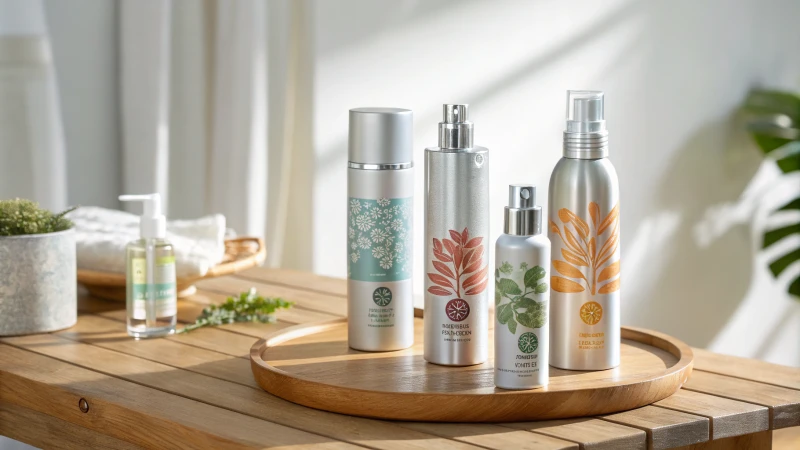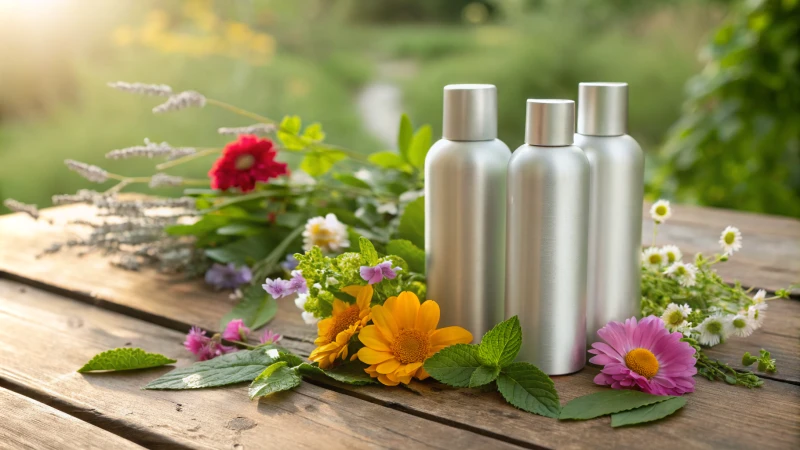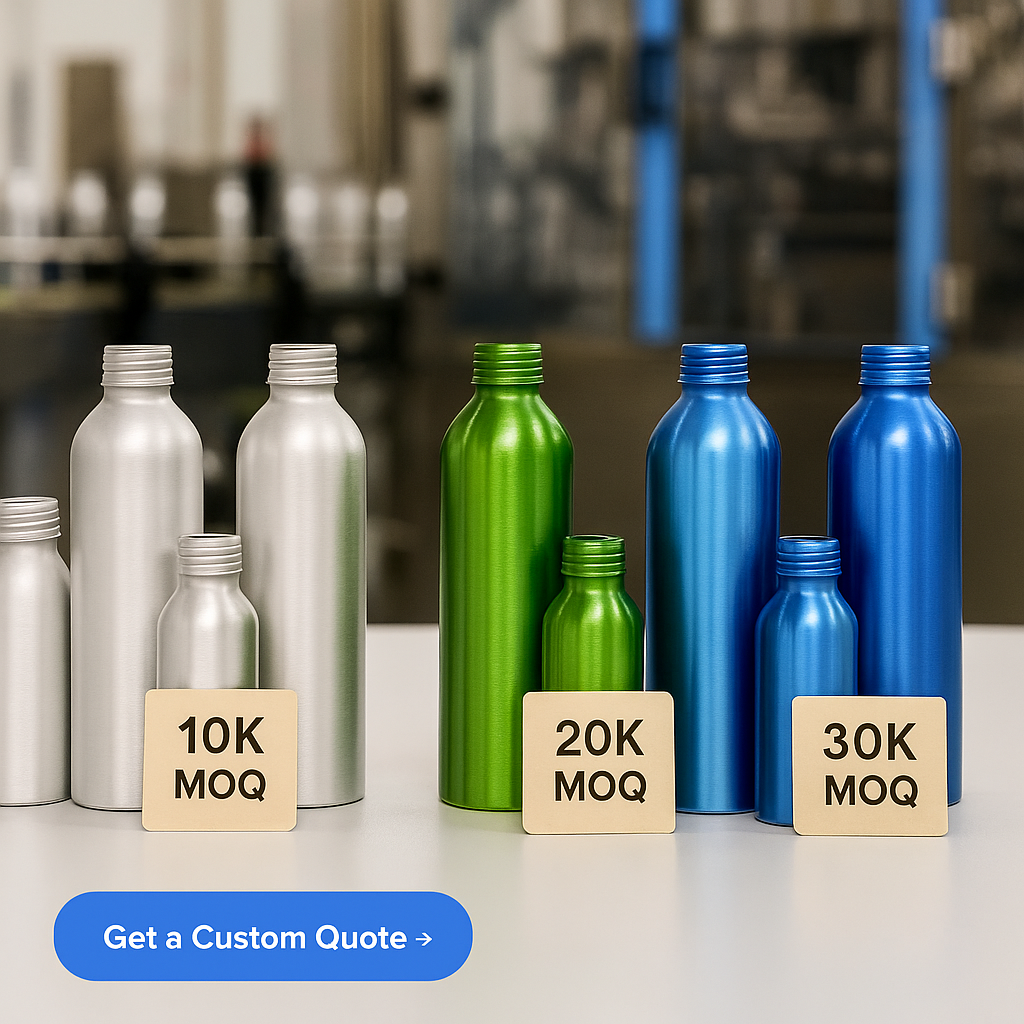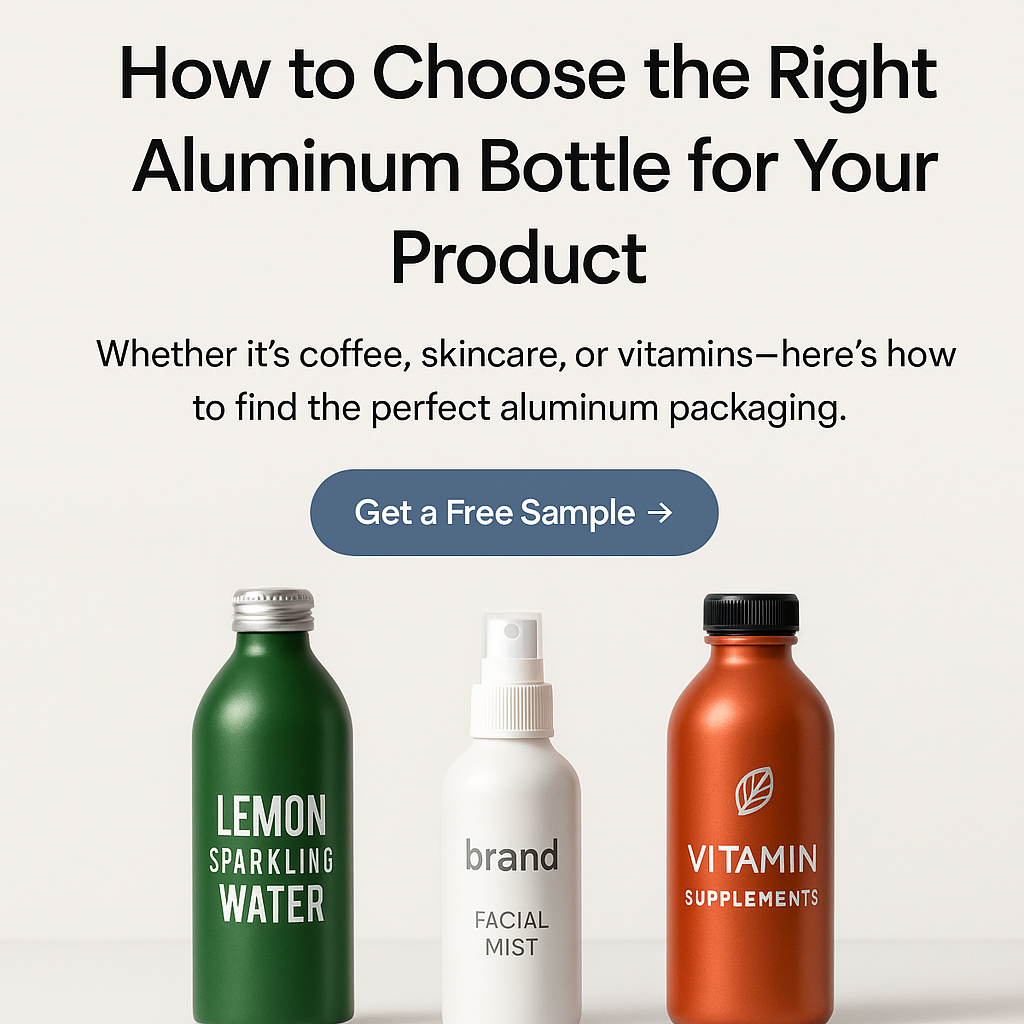
Imagine this꞉ the beauty industry receives a stylish transformation with aluminum bottles. Wondering why?
Aluminum bottles grow in popularity in the cosmetics industry. They attract attention due to their sustainability, durability and visual charm. These bottles are eco-friendly and recyclable. They really help cut down on leakage. They preserve product quality. This makes them a top choice for brands that focus on sustainability and quality control.
I remember the first time I held an aluminum bottle in my hands. Its cool touch and sleek design really stood out. It felt like finding the perfect accessory. The bottle looked good and matched my values. The shift to aluminum probably isn’t just a trend. It represents a commitment to a more sustainable future. These bottles are not just about looks. They actually have a real impact. They help reduce waste and keep your favorite products fresh and leak-free. This change is paving the way for a brighter, greener future in beauty.
Aluminum bottles are more eco-friendly than plastic ones.True
Aluminum is highly recyclable, reducing waste and environmental impact.
Aluminum packaging is less durable than glass in cosmetics.False
Aluminum is lightweight yet strong, making it highly durable.
Why Choose Aluminum Bottles for Sustainability?
Do you recall the first time you understood that your simple daily decisions could protect the Earth?
Aluminum bottles are eco-friendly. They are endlessly recyclable. They also lower carbon footprint. Production uses less energy. The lightweight design makes them very good for green-minded people. Individuals seeking sustainable options prefer them.

Recyclability of Aluminum Bottles
Aluminum really surprised me with its recyclability. Unlike plastic, which loses quality when recycled, aluminum retains its quality1 indefinitely. It acts like a superhero material; you can recycle it repeatedly without any problem.
Recycling Comparison Table:
| Material | Recyclability | Quality Loss on Recycling |
|---|---|---|
| Aluminum | High | No |
| Plastic | Moderate | Yes |
| Glass | High | No |
Energy Efficiency in Production
I was amazed by the energy saved when recycling aluminum. Producing new aluminum requires a lot of energy, but recycling cuts energy use by 95%. This is like turning off almost all the lights in a big building. This not only saves energy but also significantly lowers greenhouse gas emissions, making recycled aluminum a greener choice2.
Reduced Carbon Footprint
Aluminum bottles weigh much less than glass ones. Imagine carrying a backpack full of glass bottles—exhausting, right? Aluminum bottles lighten the load and reduce transportation emissions. When considering the full lifecycle, including production, transportation, and recycling, aluminum bottles often have a lower carbon footprint compared to both glass and plastic containers. This makes them a preferred option for businesses3 aiming to minimize their environmental impact.
Durability and Reusability
These bottles last a long time due to aluminum's durability, meaning you can reuse them many times. This decreases the need for single-use containers. Think about the times you’ve dropped a bottle; you usually worry it will shatter. Aluminum bottles don't break like that.
Consumer Perception and Eco-Branding
Environmental awareness is growing these days, leading many brands to choose aluminum for packaging. This choice increases a brand's eco-friendly credentials and can lead to increased consumer trust and loyalty among environmentally conscious customers.
In summary, considering the whole lifecycle of packaging materials is important. While it's crucial to consider this entire lifecycle, aluminum bottles present numerous advantages4 that align with sustainable practices. Choosing aluminum helps businesses and consumers reduce environmental impact through recyclable materials and efficient production processes.
Aluminum bottles are endlessly recyclable without quality loss.True
Aluminum retains its quality indefinitely through recycling, unlike plastic.
Recycling aluminum uses 50% of the energy of new production.False
Recycling aluminum uses only 5% of the energy compared to new production.
How Do Aluminum Bottles Improve Product Quality in Cosmetics?
Aluminum bottles are like superheroes for your cosmetics. These bottles keep your products fresh and effective for a longer time. They also help our planet. This packaging is innovative. It really improves product quality. It also improves sustainability.
Aluminum bottles help keep cosmetics in good condition. They block light and air to protect the products inside. This protection keeps everything fresh. These bottles do not react with the contents. So, they maintain chemical stability. Products stay uncontaminated and last longer.

Aluminum's Strong Shield
Think about finding your favorite lotion unchanged, even after many months. Aluminum bottles do this very well. They protect against light and air, which usually ruin cosmetics. I had a cream that stopped working because of bad packaging. After switching to aluminum, my creams stay very effective. They work well for a long time.
Safe and Non-Reactive
Have you ever worried about your skincare reacting in a bad way? Aluminum bottles remove this problem. They are non-reactive, ensuring the ingredients remain pure and very effective. When I think about safety, I feel calm knowing my products stay free from harmful chemicals.
Strong and Beautiful Design
Have you ever had a bottle spill inside your bag? Aluminum prevents this with its strength. Its durability really limits leaks and reduces waste. Plus, it looks sleek and stylish—like having a small piece of luxury. Aluminum represents quality and eco-friendliness.
| Advantages | Benefits |
|---|---|
| Barrier to Light | Preserves active ingredients |
| Non-Reactivity | Ensures chemical stability |
| Durability | Reduces leakage risk |
Impact on Environment and Consumers
Picking aluminum feels like helping the Earth as it is endlessly recyclable. Many consumers who care about the planet share these values. Each time I choose recyclable materials, I really feel like I'm helping with sustainability.
Real Story: A Case Study
Think about a luxury skincare brand I admire that moved from plastic to aluminum. They fixed issues with product damage due to light exposure and also improved their image for sustainability goals, enhancing customer loyalty and market competitiveness5. This change increased customer loyalty and even improved their position in the market—it’s inspiring how a simple change creates a big impact.
Aluminum bottles prevent cosmetic spoilage.True
Aluminum's barrier properties protect cosmetics from light and oxygen.
Plastic containers are more durable than aluminum.False
Aluminum is more robust, reducing damage during transport.
Are Consumers Driving the Demand for Aluminum Packaging?
I remember the first time I held one of those shiny aluminum bottles. It felt really good. But are consumers truly causing this aluminum trend? Let's explore how our shifting habits and care for the Earth are turning aluminum into the favorite choice for packaging.
Yes, I think consumers are truly pushing the demand for aluminum packaging. People want products that respect the environment. Aluminum is popular. Changing lifestyles and the need for sustainability promote aluminum. Recyclability is one reason. This material is strong. It is durable.

The Rise of Environmental Awareness
I feel like I help something bigger when I recycle. I am not alone. Many people today care more about the environment. This awareness pushes brands to act sustainably. Aluminum fits well into this eco-friendly world. It can be recycled and reused many times without losing quality, unlike plastic, which stays for hundreds of years.
Shifts in Lifestyle Choices
Every year, my life feels busier. I want convenience but not at the cost of quality. Aluminum packaging excels here by being lightweight yet strong—ideal for busy lifestyles. As cities grow, more people look for packaging solutions6 that suit their fast lives. This demand leads brands to innovate with materials like aluminum.
Market Trends and Consumer Preferences
Recent studies reflect what I see—a rise in demand for sustainable packaging7 across various sectors. Key statistics show:
| Sector | Growth in Aluminum Use |
|---|---|
| Beverage | 15% increase |
| Personal Care | 20% increase |
| Food Packaging | 12% increase |
These figures reveal a growing desire for sustainable choices. Brands that meet these desires often see greater customer loyalty and happiness.
Challenges and Opportunities
While demand is strong, challenges exist. Brands must balance costs with sustainability. Using advanced technology8 for aluminum packaging gives a needed advantage by meeting demands and improving quality, thus reducing problems like leakage—a significant issue for liquid products.
Future Prospects in Aluminum Packaging
With more industries using aluminum packaging, innovation opportunities grow. Partnerships between manufacturers and brands create unique solutions for specific needs. The future of aluminum packaging is bright with potential for further advancements in design and functionality9. The journey ahead is fascinating.
Aluminum packaging is 100% recyclable.True
Aluminum can be recycled indefinitely without losing quality.
Plastic decomposes faster than aluminum.False
Plastic takes centuries to decompose, unlike aluminum.
What are the challenges of adopting aluminum bottles in cosmetics?
Switching to aluminum bottles in cosmetics is not only about going eco-friendly. This shift involves many complex challenges.
Switching to aluminum bottles in cosmetics has some difficulties. High costs present one challenge. Another is checking if the products are safe in these bottles. Manufacturers must stop rust from damaging the bottles. Consumer opinions also matter. These issues need careful planning and smart actions. Careful strategies are essential for success. Manufacturers need to address every challenge effectively.

Cost Implications
Switching to aluminum bottles was a decision about caring for the planet and delivering quality. At first, changing to aluminum felt like facing a giant obstacle. Producing with aluminum costs more than using plastic. It was a big financial risk, but improving my brand's image and staying true to my beliefs was really important. That mattered a lot.
| Material | Average Cost | Environmental Impact |
|---|---|---|
| Plastic | Low | High (Non-biodegradable) |
| Glass | Medium | Medium (Recyclable) |
| Aluminum | High | Low (Highly Recyclable) |
Product Compatibility
Compatibility tests came next. Our team worked hard to test many formulations. Some acidic products damaged the aluminum, which threatened our products. It was like putting a square object in a round hole. Finding the perfect fit was really essential. Brands should conduct rigorous testing to ensure compatibility10.
Corrosion Potential
Aluminum is strong but still needs protection. Adding coatings seemed simple but actually complicated the process, much like adding layers to a cake where each layer must be perfect to keep things safe and stable. Choosing the right type of coating is crucial for longevity11 and product safety.
Consumer Perception
Also, people have different opinions. I remember when we talked to focus groups; some folks loved the modern look of aluminum while others thought it was too heavy or less nice-looking than glass or plastic. Teaching consumers why we picked aluminum was key—very crucial for educating consumers12 on its benefits.
Transportation and Logistics
Lastly, shipping was challenging as aluminum bottles weigh more, increasing transport costs and impacting our carbon footprint—a tricky balancing act indeed! Finding the right way to keep transportation eco-friendly was necessary for maintaining sustainability13.
Navigating these challenges showed me that using aluminum is not just about being green; it's about knowing every part of the transition and ensuring it aligns with my business goals and personal values.
Aluminum bottles increase cosmetic product costs.True
Aluminum's higher production cost compared to plastic raises product prices.
All cosmetics are suitable for aluminum packaging.False
Certain ingredients may react with aluminum, affecting product quality.
Conclusion
Aluminum bottles are gaining popularity in cosmetics due to their sustainability, durability, and ability to preserve product quality while reducing environmental impact compared to plastic and glass alternatives.
-
Learn how aluminum maintains its quality through repeated recycling cycles, highlighting its sustainable advantage. ↩
-
Discover why recycling aluminum is significantly more energy-efficient than producing new material, benefiting the environment. ↩
-
Understand how using aluminum bottles contributes to lowering carbon emissions throughout their lifecycle. ↩
-
Explore cutting-edge solutions in aluminum packaging to enhance your brand's sustainability efforts. ↩
-
Understand how eco-friendly packaging enhances brand image and customer loyalty. ↩
-
Discover how aluminum suits urban lifestyles through its convenience and durability. ↩
-
Learn about the latest sustainable packaging trends influencing various sectors. ↩
-
Understand how technology is enhancing aluminum packaging production and quality. ↩
-
Find out about cutting-edge design innovations in aluminum packaging. ↩
-
Discover which cosmetic ingredients may not be suitable for aluminum packaging to avoid product integrity issues. ↩
-
Learn about effective coatings that can protect aluminum bottles from corrosion and extend their lifespan. ↩
-
Find strategies to effectively communicate the advantages of sustainable packaging to consumers. ↩
-
Understand the impact of transportation logistics on the overall carbon footprint of cosmetic products. ↩






